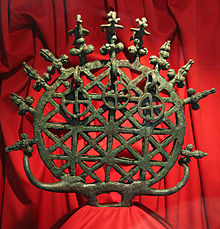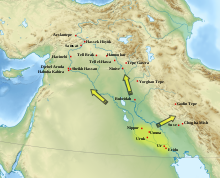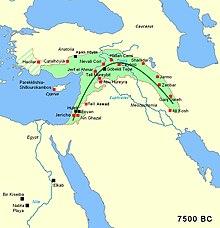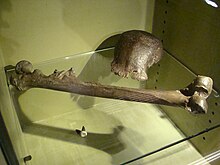User:Abyssal/Prehistory of Asia
Appearance
From Wikipedia, the free encyclopedia
Introduction

North Asia
Central Asia
East Asia
West Asia
South Asia
Southeast Asia
Prehistoric Asia refers to events in Asia during the period of human existence prior to the invention of writing systems or the documentation of recorded history. This includes portions of the Eurasian land mass currently or traditionally considered as the continent of Asia. The continent is commonly described as the region east of the Ural Mountains, the Caucasus Mountains, the Caspian Sea, Black Sea and Red Sea, bounded by the Pacific, Indian, and Arctic Oceans. This article gives an overview of the many regions of Asia during prehistoric times. (Full article...)
Selected general articles
-
Image 1
Replica of Dmanisi Skull 3, the skull of an adolescent individual, discovered in 2001
The Dmanisi hominins,' Dmanisi people, or Dmanisi man were a population of Early Pleistocene hominins whose fossils have been recovered at Dmanisi, Georgia. The fossils and stone tools recovered at Dmanisi range in age from 1.85 to 1.77 million years old,' making the Dmanisi hominins the earliest well-dated hominin fossils in Eurasia and the best preserved fossils of early Homo from a single site so early in time, though earlier fossils and artifacts have been found in Asia. Though their precise classification is controversial and disputed, the Dmanisi fossils are highly significant within research on early hominin migrations out of Africa. The Dmanisi hominins are known from over a hundred postcranial fossils and five famous well-preserved skulls, referred to as Dmanisi Skulls 1–5.
The taxonomic status of the Dmanisi hominins is somewhat unclear due to their small brain size, primitive skeletal architecture, and the range of variation exhibited between the skulls. Their initial description classified them as Homo (erectus?) ergaster (an otherwise African taxon), or potentially an early offshoot of later Asian H. erectus. The discovery of a massive jaw, D2600, in 2000 led researchers to hypothesize that more than one hominin taxon had been present at the site and in 2002, the jaw was designated as the type specimen of the new species Homo georgicus. Later analyses by the Dmanisi research team have concluded that all the skulls likely represent the same taxon with significant age-related and sexual dimorphism, though this is not a universally held view. In 2006, the team favoured subsuming the taxon under Homo erectus as H. erectus georgicus or H. e. ergaster georgicus. The nomenclature is still debated. (Full article...) -
Image 2

Ohalo II is an archaeological site in Northern Israel, near Kinneret, on the southwest shore of the Sea of Galilee. It is one of the best preserved hunter-gatherer archaeological sites of the Last Glacial Maximum, radiocarbon dated to around 23,000 BP (calibrated). It is at the junction of the Upper Paleolithic and the Epipaleolithic, and has been attributed to both periods. The site is significant for two findings which are the world's oldest: the earliest brushwood dwellings and evidence for the earliest small-scale plant cultivation, some 11,000 years before the onset of agriculture. The numerous fruit and cereal grain remains preserved in anaerobic conditions under silt and water are also exceedingly rare due to their general quick decomposition. (Full article...) -
Image 3Zarzian culture is an archaeological culture of late Paleolithic and Mesolithic in Southwest Asia.
The period of the culture is estimated to have existed about 18,000–8,000 BCE. It was preceded by the Baradostian culture in the same region and was related to the Imeretian culture of the Caucasus. (Full article...) -
Image 4
Peking Man (Homo erectus pekinensis) is a subspecies of H. erectus which inhabited what is now northern China during the Middle Pleistocene. Its fossils have been found in a cave some 50 km (31 mi) southwest of Beijing (then referred to in the West as Peking), known as the Zhoukoudian Peking Man Site. The first fossil, a tooth, was discovered in 1921, and Zhoukoudian has since become the most productive H. erectus site in the world. Peking Man was instrumental in the foundation of Chinese anthropology, and fostered an important dialogue between Western and Eastern science. Peking Man became the centre of anthropological discussion, and was classified as a direct human ancestor, propping up the Out of Asia theory that humans evolved in Asia.
Peking Man also played a vital role in the restructuring of the Chinese identity following the Chinese Communist Revolution, and was intensively communicated to the general populace to introduce them to Marxism and science. Early models of Peking Man society strongly leaned towards communist or nationalist ideals, leading to discussions on primitive communism and polygenism. This produced a strong schism between Western and Eastern interpretations, especially as the West adopted the Out of Africa theory in the late 20th century, and Peking Man's role in human evolution diminished as merely an offshoot of the human line. Though Out of Africa is now the consensus, Peking Man interbreeding with human ancestors is discussed especially in Chinese circles. (Full article...) -
Image 5The Seima-Turbino culture, also Seima-Turbinsky culture or Seima-Turbino phenomenon, is a pattern of burial sites with similar bronze artifacts. Seima-Turbino is attested across northern Eurasia, particularly Siberia and Central Asia, maybe from Fennoscandia to Mongolia, Northeast China, Russian Far East, Korea, and Japan. The homeland is considered to be the Altai Mountains. These findings have suggested a common point of cultural origin, possession of advanced metal working technology, and unexplained rapid migration. The buried were nomadic warriors and metal-workers, traveling on horseback or two-wheeled carts.
Anthony (2007) dated Seima-Turbino to "before 1900 BCE onwards." Currently, both Childebayeva (2017) and Marchenko (2017) date the Seima-Turbino complex to ca. 2200 – 1900 BCE. (Full article...) -
Image 6The Halaf culture is a prehistoric period which lasted between about 6100 BC and 5100 BC. The period is a continuous development out of the earlier Pottery Neolithic and is located primarily in the fertile valley of the Khabur River (Nahr al-Khabur), of south-eastern Turkey, Syria, and northern Iraq, although Halaf-influenced material is found throughout Greater Mesopotamia.
While the period is named after the site of Tell Halaf in north Syria, excavated by Max von Oppenheim between 1911 and 1927, the earliest Halaf period material was excavated by John Garstang in 1908 at the site of Sakce Gözü. Small amounts of Halaf material were also excavated in 1913 by Leonard Woolley at Carchemish, on the Turkish/Syrian border. However, the most important site for the Halaf tradition was the site of Tell Arpachiyah, now located in the suburbs of Mosul, Iraq. (Full article...) -
Image 7'Ubeidiya (Arabic: العبيدية, romanized: `Ubaydiyya; Hebrew: עובידיה), some 3 km south of the Sea of Galilee, in the Jordan Rift Valley, Israel, is an archaeological site of the early Pleistocene, c. 1.5 million years ago, preserving traces of one of the earliest migrations of Homo erectus out of Africa, with (as of 2014) only the site of Dmanisi in Georgia being older. The site yielded hand axes of the Acheulean type, but very few human remains. The animal remains include a hippopotamus' femur bone, and an immensely large pair of horns belonging to a species of extinct bovid.
The site was discovered in 1959 and was first excavated between 1960 and 1974. (Full article...) -
Image 8The South Asian Stone Age spans the prehistoric age from the earliest use of stone tools in the Paleolithic period to the rise of agriculture, domestication, and pottery in the Neolithic period across present-day India, Pakistan, Bangladesh, Nepal, Bhutan, and Sri Lanka. As in other parts of the world, in South Asia, the divisions of the stone age into the Paleolithic, Mesolithic, and Neolithic periods do not carry precise chronological boundaries; instead, they describe broad phases of technological and cultural development based on the tools and artifacts found at various archaeological sites.
The Paleolithic (Old Stone Age) in South Asia began as early as 2.6 million years ago (Ma) based on the earliest known sites with hominin activity, namely the Siwalik Hills of northwestern India. The Mesolithic (Middle Stone Age) is defined as a transitional phase following the end of the Last Glacial Period, beginning around 10000 BCE. The Neolithic (New Stone Age), starting around 7000 BCE, is associated with the emergence of agriculture and other hallmarks of settled life or sedentism, as opposed to hunter-gatherer lifestyles. The earliest South Asian neolithic sites include Mehrgarh in present-day Pakistan dated to 6500 BCE and Koldihwa, in present-day Uttar Pradesh, India, where domesticated rice has been radiocarbon dated to around 7000–6000 BCE. (Full article...) -
Image 9This is a list of Paleolithic sites in China. They are sorted in chronological order from the earliest founding to the latest: (Full article...)
-
Image 10Japan at the Last Glacial Maximum in the Late Pleistocene about 20,000 years ago
The Japanese Paleolithic period (旧石器時代, kyūsekki jidai) is the period of human inhabitation in Japan predating the development of pottery, generally before 10,000 BC. The starting dates commonly given to this period are from around 40,000 BC, with recent authors suggesting that there is good evidence for habitation from c. 36,000 BC onwards. The period extended to the beginning of the Mesolithic Jōmon period, or around 14,000 BC. (Full article...) -
Image 11Trialetian is the name for an Upper Paleolithic-Epipaleolithic stone tool industry from the South Caucasus. It is tentatively dated to the period between 16,000 / 13,000 BP and 8,000 BP. (Full article...)
-
Image 12The Caucasus region, on the gateway between Southwest Asia, Europe and Central Asia, plays a pivotal role in the peopling of Eurasia,
possibly as early as during the Homo erectus expansion to Eurasia,
in the Upper Paleolithic peopling of Europe,
and again in the re-peopling Mesolithic Europe following the Last Glacial Maximum, and in the expansion associated with the Neolithic Revolution. (Full article...) -
Image 13Area of the Fertile Crescent, c. 7500 BC, with main Pre-Pottery Neolithic sites. The area of Mesopotamia proper was not fully settled by humans.
Pre-Pottery Neolithic B (PPNB) is part of the Pre-Pottery Neolithic, a Neolithic culture centered in upper Mesopotamia and the Levant, dating to c. 10,800 – c. 8,500 years ago, that is, 8800–6500 BC. It was typed by British archaeologist Kathleen Kenyon during her archaeological excavations at Jericho in the West Bank, territory of Palestine.
Like the earlier PPNA people, the PPNB culture developed from the Mesolithic Natufian culture. However, it shows evidence of having more northerly origins, possibly indicating an influx from the region of northeastern Anatolia. (Full article...) -
Image 14Xiaochangliang (simplified Chinese: 小长梁; traditional Chinese: 小長梁; pinyin: Xiǎochángliáng) is the site of some of the earliest paleolithic remains in East Asia, located in the Nihewan (泥河灣) Basin in Yangyuan County, Hebei, China, most famous for the stone tools discovered there. (Full article...)
-
Image 15

One of the Alaca Höyük bronze standards from a pre-Hittite tomb dating to the 3rd millennium BC, from the Museum of Anatolian Civilizations in Ankara
The Bronze Age (c. 3300 – c. 1200 BC) was a historical period characterised principally by the use of bronze tools and the development of complex urban societies, as well as the adoption of writing in some areas. The Bronze Age is the middle principal period of the three-age system, following the Stone Age and preceding the Iron Age. Conceived as a global era, the Bronze Age follows the Neolithic, with a transition period between the two known as the Chalcolithic. The final decades of the Bronze Age in the Mediterranean basin are often characterised as a period of widespread societal collapse known as the Late Bronze Age collapse (c. 1200 – c. 1150 BC), although its severity and scope is debated among scholars.
An ancient civilisation is deemed to be part of the Bronze Age if it either produced bronze by smelting its own copper and alloying it with tin, arsenic, or other metals, or traded other items for bronze from producing areas elsewhere. Bronze Age cultures were the first to develop writing. According to archaeological evidence, cultures in Mesopotamia, which used cuneiform script, and Egypt, which used hieroglyphs, developed the earliest practical writing systems. In the Archaeology of the Americas, a five-period system is conventionally used instead, which does not include a Bronze Age, though some cultures there did smelt copper and bronze. Indigenous metalworking arrived in Australia with European contact. (Full article...) -
Image 16
Java Man (Homo erectus erectus, formerly also Anthropopithecus erectus or Pithecanthropus erectus) is an early human fossil discovered in 1891 and 1892 on the island of Java (Indonesia). Estimated to be between 700,000 and 1,490,000 years old, it was, at the time of its discovery, the oldest hominid fossil ever found, and it remains the type specimen for Homo erectus.
Led by Eugène Dubois, the excavation team uncovered a tooth, a skullcap, and a thighbone at Trinil on the banks of the Solo River in East Java. Arguing that the fossils represented the "missing link" between apes and humans, Dubois gave the species the scientific name Anthropopithecus erectus, then later renamed it Pithecanthropus erectus. The fossil aroused much controversy. Within a decade of the discovery almost eighty books or articles had been published on Dubois's finds. Despite Dubois's argument, few accepted that Java Man was a transitional form between apes and humans. Some dismissed the fossils as apes and others as modern humans, whereas many scientists considered Java Man as a primitive side branch of evolution not related to modern humans at all. In the 1930s Dubois made the claim that Pithecanthropus was built like a "giant gibbon", a much misinterpreted attempt by Dubois to prove that it was the "missing link". Eventually, similarities between Java Man and Sinanthropus pekinensis (Peking Man) led Ernst Mayr to rename both Homo erectus in 1950, placing them directly in the human evolutionary tree. (Full article...) -
Image 17

The Uruk period (c. 4000 to 3100 BC; also known as Protoliterate period) existed from the protohistoric Chalcolithic to Early Bronze Age period in the history of Mesopotamia, after the Ubaid period and before the Jemdet Nasr period. Named after the Sumerian city of Uruk, this period saw the emergence of urban life in Mesopotamia and the Sumerian civilization. The late Uruk period (34th to 32nd centuries) saw the gradual emergence of the cuneiform script and corresponds to the Early Bronze Age; it has also been described as the "Protoliterate period".
It was during this period that pottery painting declined as copper started to become popular, along with cylinder seals. (Full article...) -
Image 18Cast of Skull X at the Hall of Human Origins, Washington, D.C.
Solo Man (Homo erectus soloensis) is a subspecies of H. erectus that lived along the Solo River in Java, Indonesia, about 117,000 to 108,000 years ago in the Late Pleistocene. This population is the last known record of the species. It is known from 14 skullcaps, two tibiae, and a piece of the pelvis excavated near the village of Ngandong, and possibly three skulls from Sambungmacan and a skull from Ngawi depending on classification. The Ngandong site was first excavated from 1931 to 1933 under the direction of Willem Frederik Florus Oppenoorth, Carel ter Haar, and Gustav Heinrich Ralph von Koenigswald, but further study was set back by the Great Depression, World War II and the Indonesian War of Independence. In accordance with historical race concepts, Indonesian H. erectus subspecies were originally classified as the direct ancestors of Aboriginal Australians, but Solo Man is now thought to have no living descendants because the remains far predate modern human immigration into the area, which began roughly 55,000 to 50,000 years ago.
The Solo Man skull is oval-shaped in top view, with heavy brows, inflated cheekbones, and a prominent bar of bone wrapping around the back. The brain volume was quite large, measuring from 1,013 to 1,251 cubic centimetres (61.8 to 76.3 cu in), which is within the range of variation for present-day modern humans. One potentially female specimen may have been 158 cm (5 ft 2 in) tall and weighed 51 kg (112 lb); males were probably much bigger than females. Solo Man was in many ways similar to the Java Man (H. e. erectus) that had earlier inhabited Java, but was far less archaic. (Full article...) -
Image 19Neolithic Tibet refers to a prehistoric period in which Neolithic technology was present in Tibet.
Tibet has been inhabited since the Late Paleolithic. Paleolithic inhabitants successfully overcome the extremely harsh climate and environments and made some genetic contribution to the contemporary inhabitants. Excavated microliths on the Tibetan Plateau display mosaic features of both northern Chinese tool culture and the Tibetan Paleoliths During the mid-Holocene, Neolithic immigrants from northern China mixed with the original inhabitants, although a degree of genetic continuity with the Paleolithic settlers still exists. (Full article...) -
Image 20
Natufian culture (/nəˈtuːfiən/ nə-TOO-fee-ən) is a Late Epipaleolithic archaeological culture of the Neolithic prehistoric Levant in Western Asia, dating to around 15,000 to 11,500 years ago. The culture was unusual in that it supported a sedentary or semi-sedentary population even before the introduction of agriculture. Natufian communities may be the ancestors of the builders of the first Neolithic settlements of the region, which may have been the earliest in the world. Some evidence suggests deliberate cultivation of cereals, specifically rye, by the Natufian culture at Tell Abu Hureyra, the site of earliest evidence of agriculture in the world. The world's oldest known evidence of the production of bread-like foodstuff has been found at Shubayqa 1, a 14,400-year-old site in Jordan's northeastern desert, 4,000 years before the emergence of agriculture in Southwest Asia. In addition, the oldest known evidence of possible beer-brewing, dating to approximately 13,000 BC, was found in Raqefet Cave on Mount Carmel, although the beer-related residues may simply be a result of a spontaneous fermentation.
Generally, though, Natufians exploited wild cereals and hunted animals, notably gazelles. Archaeogenetic analysis has revealed derivation of later (Neolithic to Bronze Age) Levantines primarily from Natufians, along with substantial later gene flow from Anatolia. (Full article...) -
Image 21The extent of the BMAC (according to the Encyclopedia of Indo-European Culture)
The Bactria–Margiana Archaeological Complex (BMAC) is the modern archaeological designation for a particular Middle Bronze Age civilisation of southern Central Asia, also known as the Oxus Civilization. The civilisation's urban phase or Integration Era, was dated in 2010 by Sandro Salvatori to c. 2400–1950 BC, but a different view is held by Nadezhda A. Dubova and Bertille Lyonnet, c. 2250–1700 BC.
Though it may be called the "Oxus civilization", apparently centred on the upper Amu Darya (Oxus River) in Bactria, most of the BMAC's urban sites are actually located in Margiana (modern Turkmenistan) on the Murghab river delta, and in the Kopet Dagh mountain range. There are a few later (c. 1950–1450 BC) sites in northern Bactria, currently known as southern Uzbekistan, but they are mostly graveyards belonging to the BMAC-related Sapalli culture. A single BMAC site, known as Dashli, lies in southern Bactria, current territory of northern Afghanistan. Sites found further east, in southwestern Tajikistan, though contemporary with the main BMAC sites in Margiana, are only graveyards, with no urban developments associated with them. (Full article...) -
Image 22This list of Bronze Age sites in China includes sites dated to either the Chinese Bronze Age, or Shang and Western Zhou according to the dynastic system. It is currently based on China's Major Historical and Cultural Site Protected at the National Level record. (Full article...)
Things you can do
Desired articles, sorted by how frequently linked to:
- Archaeology of Asia
- Archaeology of Japan
- Archaeology of Tajikistan
- Archaeology of Brunei
- Archaeology of Iraq
- Archaeology of Cambodia
- Archaeology of Jordan
- Archaeology of Kyrgyzstan
- Archaeology of Laos
- Archaeology of Bangladesh
- Archaeology of Kuwait
- Archaeology of Christmas Island
- Archaeology of Bhutan
- Archaeology of Egypt
- Archaeology of Georgia (country)
- Archaeology of South Korea
- Archaeology of East Timor
- Archaeology of Hong Kong
- Archaeology of Sri Lanka
- Archaeology of Iran
- Archaeology of South Ossetia
- Archaeology of Saudi Arabia
- Archaeology of Macau
- Archaeology of Kazakhstan
- Archaeology of Taiwan
- Archaeology of the Palestinian territories
- Archaeology of the Republic of Artsakh
- Archaeology of Abkhazia
- Archaeology of the Maldives
- Archaeology of the Cocos (Keeling) Islands
- Archaeology of Turkmenistan
- Archaeology of Turkey
- Archaeology of Thailand
- Archaeology of Uzbekistan
- Archaeology of Vietnam
- Archaeology of the British Indian Ocean Territory
- Archaeology of Yemen
- Archaeology of Bahrain
- Archaeology of Nepal
- Archaeology of Syria
- Archaeology of Mongolia
- Archaeology of Malaysia
- Archaeology of Myanmar
- Archaeology of North Korea
- Budana
- John David Hawkins
- Gyanpura
- Kheri Lochab
- Khera Gandawala
- Rajpura, Narnaund
- Kagsar
- Nara, Hisar
- Sulchani
- Kinnar, Hisar
- Panihari village
- Gamra
- Pali, Narnaund
- Ukhaa Tolgod
- Geology of Asia
- Kurile arc
- Xinminpu Group
- Zhou Shiwu
- You Hailu
- Wang Xiaolin
- Paul Upchurch
- Shandong Tianyu Museum of Nature
- Cyclopygoidea
- Diapophysis
- Changma Basin
- Ukhaa Tolgod
- Kenilworth Sandstone Formation
- He Xinlu
- Cyclopygoidea
Selected images
-
Image 1The Ancient Paleo-Siberians formed from the Ancient North Eurasians and Ancient Northern East Asian ancestry, and are closely connected to the first wave of humans into the Americas. (from Prehistoric Asia)
-
Image 3Dolmen from Godavari district, Andhra Pradesh, India. Woodcut from the article "Indiska fornsaker" by Hans Hildebrand. (from Prehistoric Asia)
-
Image 4Modern reproduction of a skull of Homo erectus georgicus from Dmanisi in modern Georgia (Caucasus), the earliest evidence for the presence of early humans outside the African continent. (from Prehistoric Asia)
-
Image 5Map of AsiaNorth AsiaCentral AsiaEast AsiaWest AsiaSouth AsiaSoutheast Asia(from Prehistoric Asia)
-
Image 7Early Indo-European migrations from the Pontic steppes and across Central Asia, and encounter with Ancient Northeast Asian populations. (from Prehistoric Asia)
-
Image 8Modern humans interbred with an archaic human species called Denisovans on the islands of Southeast Asia. (from Prehistoric Asia)
Subcategories
Related portals
Associated Wikimedia
The following Wikimedia Foundation sister projects provide more on this subject:
-
Commons
Free media repository -
Wikibooks
Free textbooks and manuals -
Wikidata
Free knowledge base -
Wikinews
Free-content news -
Wikiquote
Collection of quotations -
Wikisource
Free-content library -
Wikiversity
Free learning tools -
Wiktionary
Dictionary and thesaurus
- What are portals?
- List of portals











































